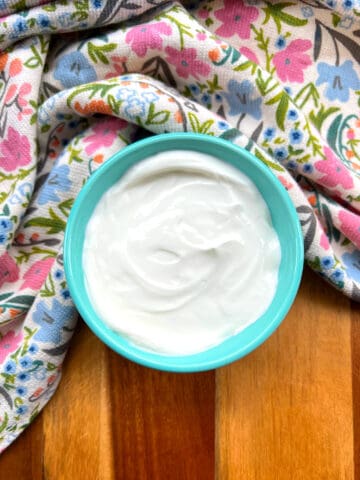This soft spread comes in a couple of different styles, and it can add a slight sweetness to foods. But can you freeze clotted cream? Or will that sacrifice its signature taste and smooth texture?

A favorite at afternoon tea in Great Britain, clotted cream is soft, airy, and often used on baked goods like scones, quick bread, or muffins.
But what if you have some left over and you want to store it long-term? Does clotted cream freeze well?
You can freeze clotted cream for up to 6 months. But like trying to freeze other types of dairy, it can be tricky, as you’ll likely notice some changes to its original creamy texture when you defrost it.
Still, if necessary, freezing can be a good way to save leftover clotted cream for long periods of time. You just need to follow a few simple steps.
Jump to:
What is clotted cream?
Clotted cream originated in Britain and dates back centuries. The traditional variety hails from the southwestern English county of Devon. Residents made it as a way to extend the shelf life of milk. You know, since refrigerators hadn’t been invented yet!
Clotted cream was made by simmering full cow’s milk in a large shallow dish for several hours, until the cream produced a thick upper crust. This separated the fat from the rest of the milk. Once it all cooled down, the soft crust was then scooped out and used as a buttery cream. And the leftover skim milk could be consumed separately.
Not to be outdone, residents in neighboring Cornwall began making their own style of clotted cream. Their process was similar, but rather than resulting in separate layers of cream and milk, you were left with a thick, solid layer of clotted cream.
Today, clotted cream is sometimes referred to as Devonshire cream, Devon cream, or Cornish cream.
How does clotted cream taste?
Clotted cream has a similar flavor to unsalted butter, with a slight sweetness and nuttiness and a light yellow color.
And this thick cream is very rich, featuring a high fat content. In fact, it contains a whopping 55% butterfat, which results in a sort of buttery, cream cheese-like texture. In contrast, regular cream cheese only has about 36% butterfat.

It’s commonly used in place of butter as a spread, and it’s a particular favorite to use on homemade scones along with strawberry jam or raspberry jam.
In addition, this luxurious cream can take the place of whipped cream alongside a bowl of fresh berries, to add a bit of sweetness.
How to freeze clotted cream
While clotted cream is best consumed fresh, it is possible to freeze it and save it for later. While you may detect some graininess in the texture after the cream freezes, there are ways to address it so it becomes creamy again. I’ll point these out below.
But first, here’s how to freeze this delicious treat for future use:
- If you have unopened store-bought clotted cream, you can simply place the original container or jar in the freezer and keep it there until you’re ready to use it.
- If you’ve already opened it or you made your own clotted cream at home, you’ll need to transfer it to an airtight, freezer-safe container. This will help prevent freezer burn and ice crystals from forming. And it will help keep the cream from drying out.
- Then simply label your containers with the storage date.
Clotted cream stored properly will last for up to 6 months in the freezer.
💡 Tip: If you have a large amount of clotted cream, freeze it in small batches in separate containers. That way, you only need to defrost the amount you plan to consume.
How to defrost clotted cream
When you’re ready to thaw out your frozen clotted cream, the best way is to take your time.
Transfer the sealed container from the freezer to the fridge and let the cream defrost for several hours or overnight.
It should keep for up to 3 days in the fridge.
💡 If you find that the texture of your thawed-out clotted cream has become crumbly during the freezing process, whip it with a whisk to try to recapture some of its original creaminess.
💡 For best results, try to serve it with something warm like a heated-up scone or muffin. This will cause the clotted cream to melt a bit and it can be a great way to make any graininess less noticeable.
❌ Avoid trying to defrost it in the microwave. You could start to cook the cream inadvertently. And it may start to break down and become grainy.
❌ Also, don’t let it simply thaw at room temperature, as it could spoil and become inedible.
How long will clotted cream keep in the fridge?
Clotted cream has a fairly short shelf life. Homemade clotted cream will keep for up to 5 days in the refrigerator if kept in an airtight container.
Store-bought clotted cream needs to be kept in the fridge. Unopened, it will stay good for up to 2 weeks or until the best-by date. Once opened, it will stay fresh for up to 3 days.
How do I know if clotted cream has spoiled?
To determine if clotted cream has gone bad, look for a few tell-tale signs.
If it’s become dried-out and crumbly, this is an indication that the clotted cream is past its prime.
If it has a sour or rancid odor, this also means it’s likely started to spoil.
And if you notice discoloration such as a significant darkening in the cream’s original light yellow, then it may be going bad.
In any of these cases, it’s a good idea to discard the clotted cream.
How to make homemade clotted cream: step-by-step
Clotted cream is widely available at specialty grocery stores, but it’s also easy to make on your own. All you need is heavy cream, and a lot of patience. Here are step-by-step directions:
Step 1 – Measure out 4 cups of heavy cream.
Step 2 – Pour the cream into a 9-inch glass baking dish. It should fill the dish and be about 1.5 inches high.
Step 3 – Place in the oven at 180° Fahrenheit and bake for 12 hours.
Step 4 – Remove from the oven and let cool until it reaches room temperature.
Step 5 – Then cover it with plastic wrap or cling film and chill in the fridge for several more hours, or overnight (up to 12 more hours). A thick layer will form on the top.
Step 6 – When thoroughly chilled, drain the leftover liquid from the baking dish. To do this, use a large spoon to carefully pull back one corner of the cream, then pour the liquid into a separate bowl.
Step 7 – Mix the thick layer of cream from the original baking dish until you have a buttery-like clotted cream. Transfer it to resealable glass jars or other airtight containers and place them in the fridge.

FAQ
Like with many other dairy products, clotted cream doesn’t freeze very well. After you thaw it out, rather than having its signature soft creamy texture, you’ll likely notice an unpleasant graininess. Still, it’s possible to freeze clotted cream for up to 6 months.
While both are made with heavy cream, clotted cream is thicker and less airy than whipped cream. So it has a denser consistency that’s closer to whipped butter. Clotted cream is also not as sweet as whipped cream. Finally, the two are made in different ways. Whipped cream is created by simply whipping heavy cream until it’s soft and pillowy. The process for making clotted cream involves heating and separating heavy cream for several hours.
More food storage answers
Find out whether you can freeze more of your favorite foods. Check out these posts.






Leave a Reply